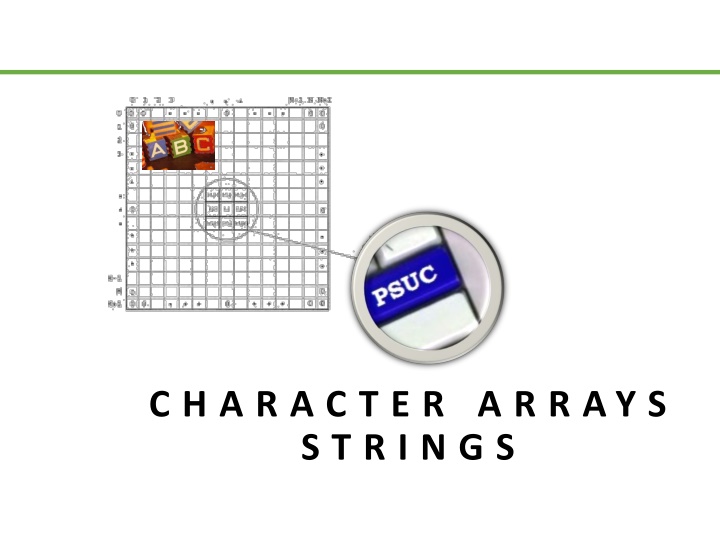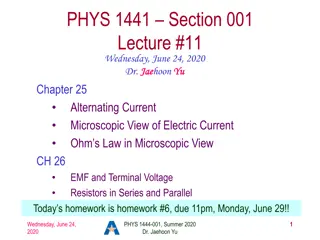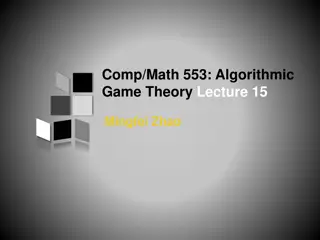
Character Arrays and Strings in Programming
Explore the fundamentals of character arrays and strings in programming, including definitions, declarations, initialization methods, and common operations. Learn how to work with arrays of characters and string literals to build meaningful and readable programs effectively.
Download Presentation

Please find below an Image/Link to download the presentation.
The content on the website is provided AS IS for your information and personal use only. It may not be sold, licensed, or shared on other websites without obtaining consent from the author. If you encounter any issues during the download, it is possible that the publisher has removed the file from their server.
You are allowed to download the files provided on this website for personal or commercial use, subject to the condition that they are used lawfully. All files are the property of their respective owners.
The content on the website is provided AS IS for your information and personal use only. It may not be sold, licensed, or shared on other websites without obtaining consent from the author.
E N D
Presentation Transcript
C H A R A C T E R A R R A Y S S T R I N G S
S t r i n g s Definition A string is an array of characters. Any group of characters (except double quote sign) defined between double quotation marks is a constant string. Character strings are often used to build meaningful and readable programs. The common operations performed on strings are Reading and writing strings Combining strings together Copying one string to another Comparing strings to another Extracting a portion of a string ..etc. 4/16/2025 CSE 1001 Department of CSE 2
S t r i n g s Declaration and initialization char char string_name string_name[ [size The size determines the number of characters in the string_name size] ]; ; string_name. For example, consider the following array: char char name name [ [20 20] ]; ; is an array that can store up to 20 elements of type char char. It can be represented as: 4/16/2025 CSE 1001 Department of CSE 3
S t r i n g s The character sequences "Hello" and "Merry Christmas" represented in an array name name respectively are shown as follows : 4/16/2025 CSE 1001 Department of CSE 4
Initialization of null-terminated character sequences arrays of characters or strings are ordinary arrays that follow the same rules of arrays. For example To initialize an array of characters with some predetermined sequence of characters one can initialize like any other array: char myWord[ ] = { 'H', 'e', 'l', 'l', 'o', '\0' }; 4/16/2025 CSE 1001 Department of CSE 5
Initialization of null-terminated character sequences Arrays of char elements have an additional methods to initialize their values: using string literals Manipal is a constant string literal. For example, char result[14] = Manipal ; Double quoted (") strings are literal constants whose type is in fact a null- terminated array of characters. So string literals enclosed between double quotes always have a null character ('\0') automatically appended at the end. 4/16/2025 CSE 1001 Department of CSE 6
Initialization Initialization: char myWord [ ] = { 'H', 'e', 'l', 'l', 'o', '\0' }; char myWord [ ] = "Hello"; In both cases the array of characters myword is declared with a size of 6 elements of type char: The 5 characters that compose the word "Hello" plus a final null character ('\0') which specifies the end of the sequence and that, In the second case, when using double quotes (") null character ('\0') is appended automatically. 4/16/2025 CSE 1001 Department of CSE 7
Example #include <stdio.h> int main() { char question[ ] = "Please, enter your first name: "; char greeting[ ] = "Hello, "; char yourname [ 80]; printf( %s ,question); scanf( %s , &yourname); printf( %s . %s\n ,greeting, yourname ); return 0; Please, enter your first name: gautam Hello, ... gautam } 4/16/2025 CSE 1001 Department of CSE 8
Example #include <stdio.h> int main() { const int MAX = 80; //max characters in string char str[MAX]; //string variable str printf("Enter a string: \n"); scanf("%s",&str); //put string in str printf("%s",str); //display string from str return 0; Enter a string: gautam kumar gautam } 4/16/2025 CSE 1001 Department of CSE 9
Reading Embedded Blanks To read everything that you enter from the keyboard until the ENTER key is pressed (including space). Syntax: gets(string) gets(string) ; ; CSE 1001 Department of CSE 4/16/2025 10
Example #include <stdio.h> #include<string.h> int main() { char str[80]; //string variable str printf( \nEnter a string: ); gets(str); //put string in str or use gets(str) printf( the string is \n ); puts(str); Enter a string: Manipal University Jaipur, India The Entered String is Manipal University Jaipur, India return 0; } 4/16/2025 CSE 1001 Department of CSE 11
Count the number of characters in a string gets(sent); #include <stdio.h> puts(sent); while(sent[i]!='\0') int main() { { count++; char sent[100]; i++; int i=0, count=0; } printf( \n The No of characters=%d , count); printf("enter sentence \n ); return 0; } 4/16/2025 CSE 1001 Department of CSE 12
Count the number of words in a sentence #include <stdio.h> while(sent[i]!='\0') { if (sent[i]==' '&& sent[i+1]!=' ') count++; i++; } printf( n %d n no. of words = " ,count); return 0; } int main() { const int MAX = 100; char sent[MAX]; int i=0,count=1; printf("enter sentence \n ); gets(sent); printf("\n ); 4/16/2025 CSE 1001 Department of CSE 13
Reading multiple lines: Example #include <stdio.h> Example printf("You entered:\n ); int main() printf( %s ,str); { return 0; const int MAX = 2000; } //max characters in string char str[MAX]; //string variable str printf("\nEnter a string:\n ); gets(str); The function will continue to accept characters until enter key is pressed. 4/16/2025 CSE 1001 Department of CSE 14






















